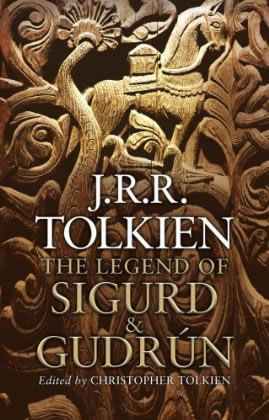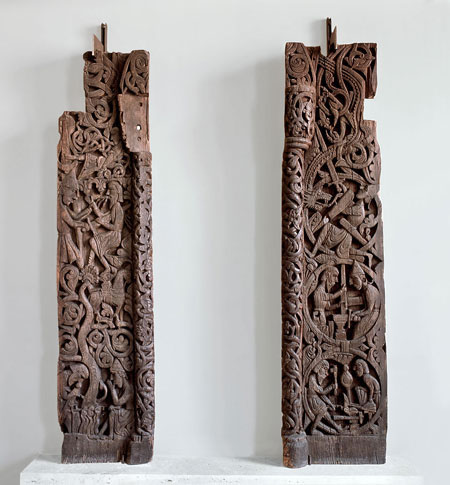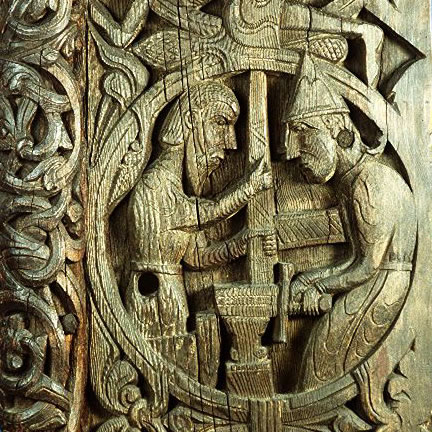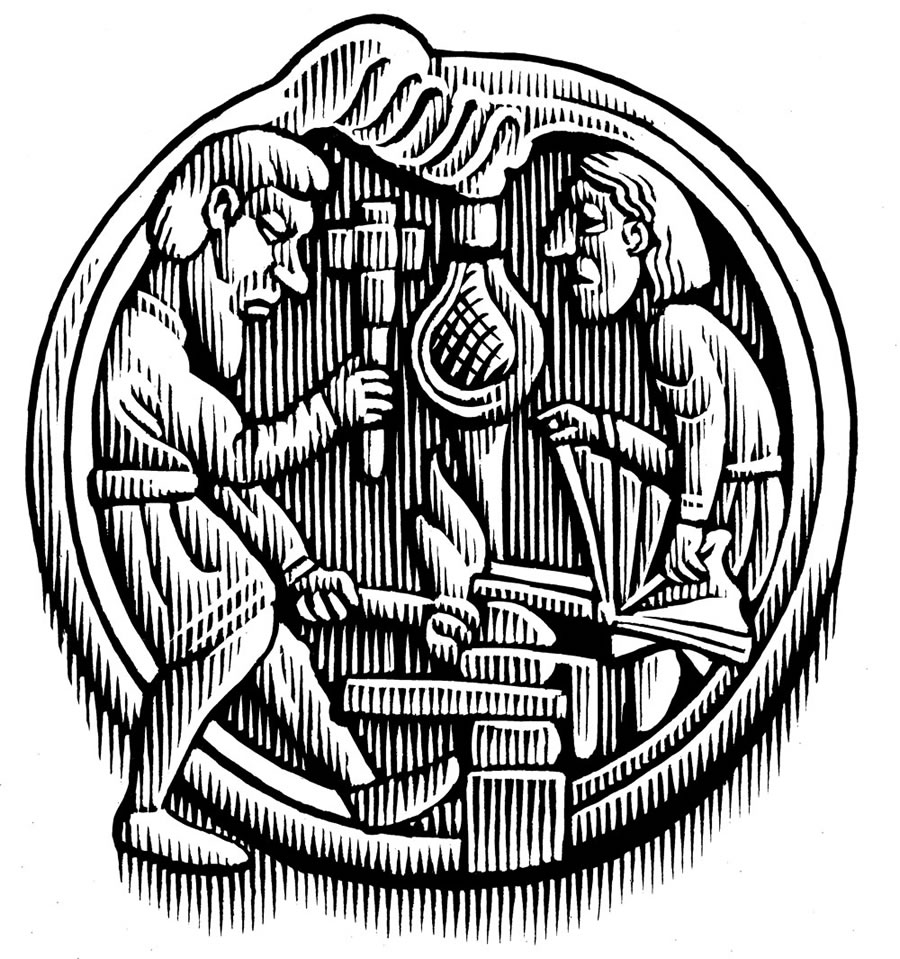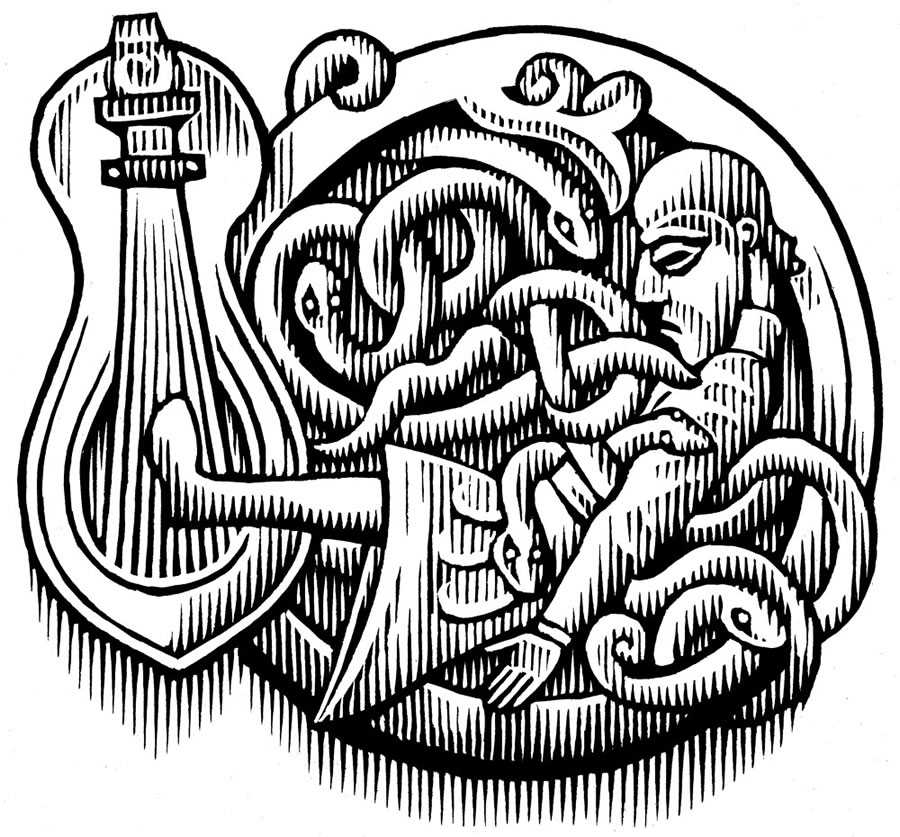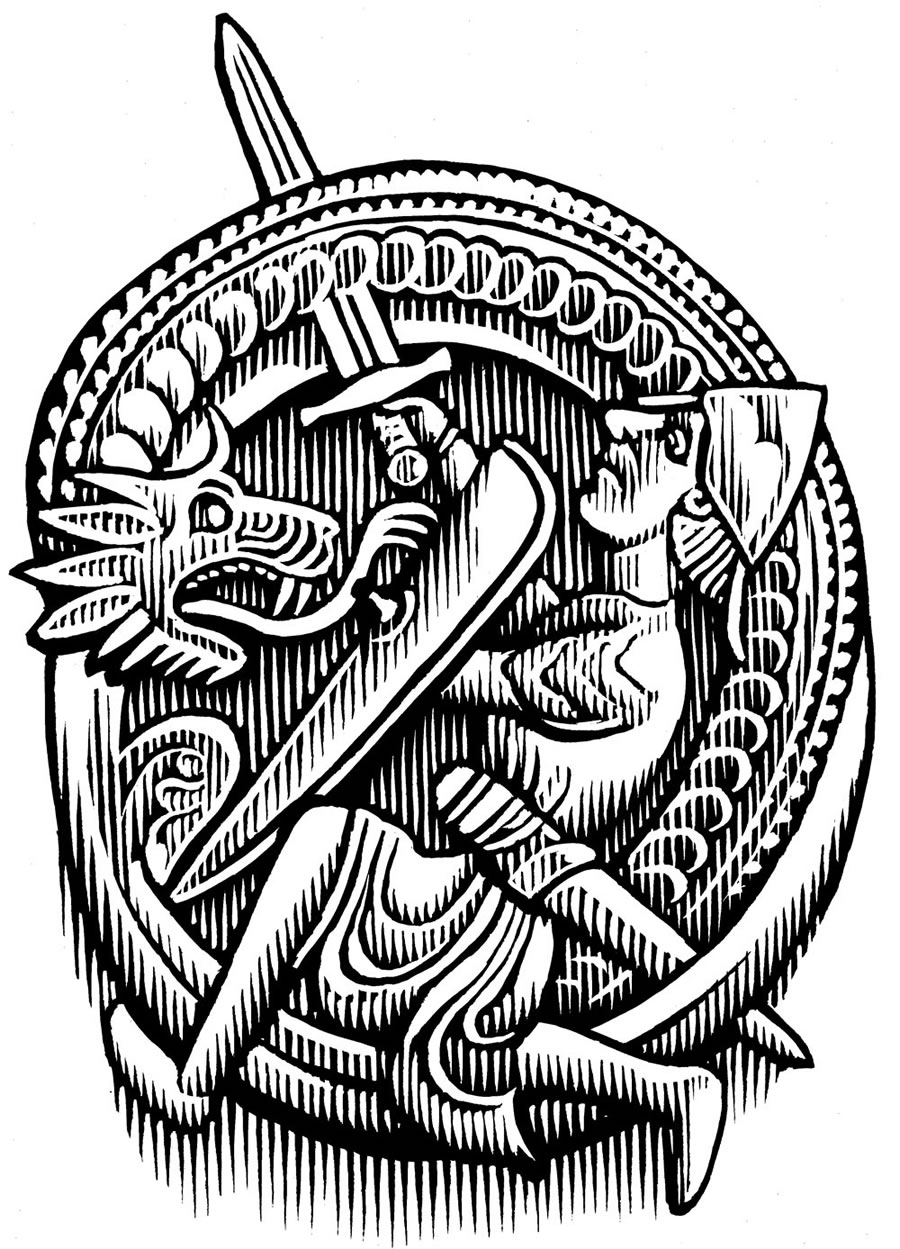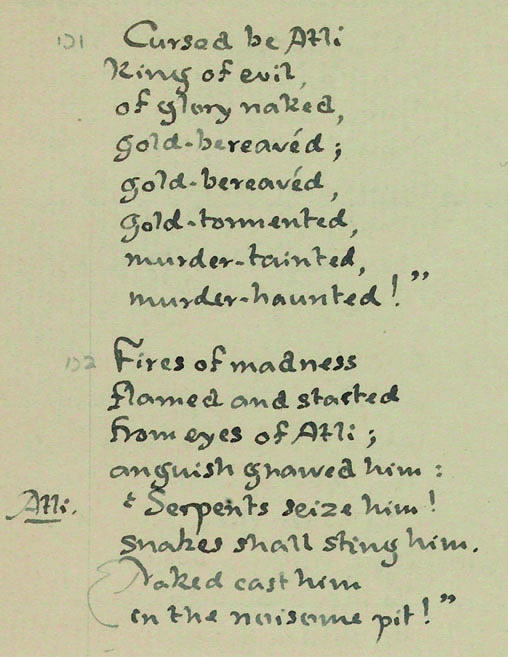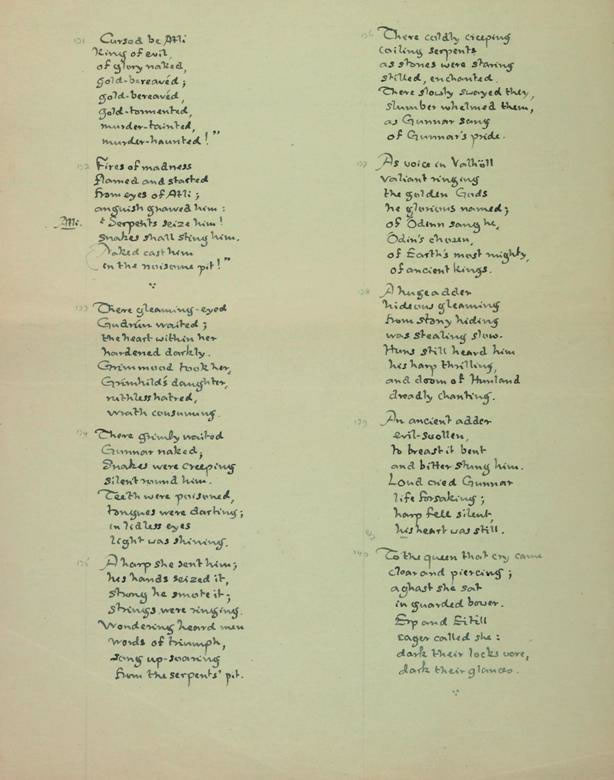The Legend of Sigurd and Gudrun FAQ - all info on the new book by J.R.R. Tolkien (17.02.09 by Pieter Collier) - Comments
When did J.R.R. Tolkien write The Legend of Sigurd and Gudrun?
The previously unpublished work was written while Tolkien was professor of Anglo-Saxon at Oxford University during the 1920s and '30s, before he wrote The Hobbit and The Lord of the Rings. The publication will make available for the first time tolkien's extensive retelling in English narrative verse of the epic Norse tales of Sigurd the Völsung and the Fall of the Niflungs.
Have pieces of this work been published before?
It will be the world first publication of a previously unknown work by J.R.R. Tolkien, which tells the epic story of the Norse hero, Sigurd, the dragon-slayer, the revenge of his wife, Gudrun, and the Fall of the Nibelungs. No part has ever been reproduced or quoted from since it was written over 70 years ago.
Have pieces of this work been published before?
It will be the world first publication of a previously unknown work by J.R.R. Tolkien, which tells the epic story of the Norse hero, Sigurd, the dragon-slayer, the revenge of his wife, Gudrun, and the Fall of the Nibelungs. No part has ever been reproduced or quoted from since it was written over 70 years ago.
Is this book strongly edited?
It will appear complete and unaltered, as J.R.R. Tolkien wrote it.
What is so special about the introduction?
Introducing the work is one of tolkien's lectures on Norse literature, so you get to 'hear' the voice of the author as he would have spoken when introducing the legends to students.
Why are these legends interesting to Tolkien fans?
The Norse legends and sagas were the single greatest influence on tolkien's writings, and many of the events in Sigurd and Gudrun can be traced through to The Hobbit, The Lord of the Rings and The Children of Hurin.
Where does the cover image come from?
The Hylestad stave church was pulled down in the 19th century, but one of its portals is now exhibited at the University Museum of Antiquities in Oslo. The carving on this portal shows several scenes from the legend of Sigurd Fåvnesbane.
Will there be any illustrations inside this new book?
As told by David Brawn in this interview the book will feature a small number of decorative illustrations by an artist called Bill Sanderson, which are historically appropriate and very striking. HERE is an interview with the artist.
These are illustrations used in the new Tolkien book:
Many years ago, J.R.R. Tolkien composed his own version, now published for the first time, of the great legend of Northern antiquity, in two closely related poems to which he gave the titles The New Lay of the Völsungs and The New Lay of Gudrun.
The New Lay of the Völsungs
In the Lay of the Völsungs is told the ancestry of the great hero Sigurd, the slayer of Fafnir most celebrated of dragons, whose treasure he took for his own; of his awakening of the Valkyrie Brynhild who slept surrounded by a wall of fire; and of his coming to the court of the great princes who were named the Niflungs (or Nibelungs), with whom he entered into blood-brotherhood. In that court there sprang great love but also great hate, brought about by the power of the enchantress, mother of the Niflungs, skilled in the arts of magic, of shape-changing and potions of forgetfulness. In scenes of dramatic intensity, of confusion of identity, thwarted passion, jealousy and bitter strife, the tragedy of Sigurd and Brynhild, and Gudrun his sister, mounts to its end in the murder of Sigurd at the hands of his blood-brothers, the suicide of Brynhild, and the despair of Gudrun.
The New Lay of Gudrun
In the Lay of Gudrun her fate after the death of Sigurd is told, her marriage against her will to the mighty Atli, ruler of the Huns (the Attila of history), his murder of her brothers, and her hideous revenge.
tolkien's sources
Deriving his version primarily from his close study of the ancient poetry of Norway and Iceland known as the Poetic Edda (and from the later prose work the Völsunga Saga), Tolkien employed a verse-form whose lines embody in English the exacting alliterative rhythms and the concentrated energy of the poems of the Edda.
Can I see an original page of the original pages from tolkien's own manuscript?
This page is being used as the frontispiec in the Legend of Sigurd and Gudrun hardback and Deluxe Edition.
It shows Tolkien fine handwriting and smooth way of writing the original manuscript in Norse verse form.
The following promotional videos have been released:
For the release of the book their were distributed several promotional items like bookmarks, posters and leaflets. During the release event of the book there was also shown a video of Tolkien that was previously not shown anywhere.
All the different editions that will be released:
Type: Hardback Edition
Extent: 384 pages
Format: 143x222mm
Publisher: HarperCollins
Publication date:
05/05/2009 (UK)
05/05/2009 (NZ)
05/05/2009 (AU)
Language: English
ISBN-10: 0007317239
ISBN-13: 978-0007317233
Next to the standard hardback edition there will be released a deluxe slipcased edition of the work, published as part of a collectible series of superior editions of J.R.R. tolkien's work. This will very much look like the other deluxe editions, but will have a brown colour.
Type: Deluxe Edition, Hardback, and slipcase
Extent: 384 pages
Format: 143x222mm
Publisher: HarperCollins
Publication date:
05/05/2009 (UK)
Language: English
ISBN-10: 0007317255
ISBN-13: 978-0007317257
Also the audio book fans will not be forgotten, also on 5 May there will be released a 5CD version and the new Tolkien book will be sold as a downloadable audiobook. There will even be a version for sale for Iphone users!
The audio book will be read by Brian Denis Cox, (born June 1, 1946) who is a BAFTA- and Emmy Award-winning, Golden Globe-nominated British actor. Cox narrated an abridged audio book version of Sir Walter Scott's novel Ivanhoe, and an unabridged audio book of JRR tolkien's The Silmarillion.
Type: Unabridged edition edition; CD-audio, 5 CDs
Publisher: HarperCollins
Publication date: 5 May 2009
Language: English
ISBN-10: 0007318820
ISBN-13: 978-0007318827
Type: Unabridged Windows Media edition; Downloadable audio
Publisher: HarperCollins
Publication date: 5 May 2009
Language: English
ISBN-10: 0007318847
ISBN-13: 978-0007318841
Type: Unabridged Audible edition; Downloadable audio
Publisher: HarperCollins
Publication date: 5 May 2009
Language: English
ISBN-10: 0007318839
ISBN-13: 978-0007318834
Type: Unabridged OMA Mobile edition; Downloadable audio
Publisher: HarperCollins
Publication date: 5 May 2009
Language: English
ISBN-10: 0007318855
ISBN-13: 978-0007318858
Will the new Tolkien book also be released in the US?
According to Associated Press The Legend of Sigurd and Gudrun, will be published in May by Houghton Mifflin Harcourt.
Type: hardcover
Estimate: 384 pages
Publisher: Houghton Mifflin Harcourt
Publication date: 5 May 2009
Language: English
ISBN-10: 0547273428
ISBN-13: 978-0547273426
Type: Deluxe edition
Estimate: 384 pages
Publisher: Houghton Mifflin Harcourt
Publication date: 2 June 2009
Language: English
ISBN-10: 0547296282
ISBN-13: 978-0547296289
A super deluxe edition
Next to that there will be available a Super Deluxe Edition limited to 500 copies worldwide, signed by Christopher Tolkien.
Containing five reproductions of original mansucript pages, it is hand-bound in full goat-skin and features raised spine ribs; the pages are edged in gold. The book is housed in a matching leather traycase lined in real suede and protected in its own shipping carton. It will ressemble the signed limited Deluxe edition of The Children of Hurin, but will be brown.
Translations of the new Tolkien book The Legend of Sigurd and Gudrun
Because there will be numerous editions made in several languages I will keep track of these on a different page: all translations of the new Tolkien book.
On Amazon there has been released Part I of the foreword for the new book. It is brilliantly written by Christopher Tolkien and really makes you want to read the upcoming book. Here it is reproduced:
FOREWORD
Part I
In his essay On fairy-stories (1947) my father wrote of books that he read in his childhood, and in the course of this he said:
I had very little desire to look for buried treasure or fight pirates, and Treasure Island left me cool. Red Indians were better: there were bows and arrows (I had and have a wholly unsatisfied desire to shoot well with a bow), and strange languages, and glimpses of an archaic mode of life, and above all, forests in such stories. But the land of Merlin and Arthur were better than these, and best of all the nameless North of Sigurd and the Völsungs, and the prince of all dragons. Such lands were pre-eminently desirable.
That the ancient poetry in the Old Norse language known by the names of the Elder Edda or the Poetic Edda remained a deep if submerged force in his later life’s work is no doubt recognized. It is at any rate well-known that he derived the names of the dwarves in The Hobbit from the first of the poems in the Edda, the Völuspá, ‘the Prophecy of the Sibyl’ – remarking in a lightly sardonic but not uncharacteristic tone to a friend in December 1937:
I don’t much approve of The Hobbit myself, preferring my own mythology (which is just touched on) with its consistent nomenclature ... to this rabble of Eddaic-named dwarves out of Völuspá, newfangled hobbits and gollums (invented in an idle hour) and Anglo-Saxon runes.
But it is certainly not well-known, indeed scarcely known at all (though it can be discovered from existing publications), that he wrote two closely associated poems treating of the Völsung and Niflung (or Nibelung) legend, using modern English fitted to the Old Norse metre, amounting to more than five hundred stanzas: poems that have never been published until now, nor has any line been quoted from them. These poems bear the titles Völsungakviða en nýja, the New Lay of the Völsungs, and Guðrúnarkviða en nýja, the New Lay of Gudrún.
My father’s erudition was by no means confined to ‘Anglo-Saxon’, but extended to an expert knowledge of the poems of the Elder Edda and the Old Norse language (a term that in general use is largely equivalent to Old Icelandic, since by far the greater part of Norse literature that survives is written in Icelandic). In fact, for many years after he became the professor of Anglo-Saxon at Oxford in 1925 he was the professor of Old Norse, though no such title existed; he gave lectures and classes on Norse language and literature in every year from 1926 until at least 1939. But despite his accomplishment in this field, which was recognized in Iceland, he never wrote anything specifically on a Norse subject for publication – except perhaps the ‘New Lays’, and for this, so far as I know, there is no evidence one way or the other, unless the existence of an amanuensis typescript, of unknown date and without other interest, suggests it. But there survive many pages of notes and draftings for his lectures, although these were for the most part written very rapidly and often on the brink of illegibility or beyond.
The ‘New Lays’ arose from those studies and belong to that time. My inclination is to date them later rather than earlier in his years at Oxford before the Second War, perhaps to the earlier 1930s; but this is scarcely more than an unarguable intuition. The two poems, which I believe to have been closely related in time of composition, constitute a very substantial work, and it seems possible, as a mere guess, since there is no evidence whatsoever to confirm it, that my father turned to the Norse poems as a new poetic enterprise after he abandoned the Lay of Leithian (the legend of Beren and Lúthien) near the end of 1931 (The Lays of Beleriand, p.304).
These poems stand in a complex relation to their ancient sources; they are in no sense translations. Those sources themselves, various in their nature, present obscurities, contradictions, and enigmas: and the existence of these problems underlay my father’s avowed purpose in writing the ‘New Lays’.
He scarcely ever (to my knowledge) referred to them. For my part, I cannot recollect any conversation with him on the subject until very near the end of his life, when he spoke of them to me, and tried unsuccessfully to find them. But he briefly mentioned the work in two letters to W.H. Auden. In that of 29 March 1967 (The Letters of J.R.R. Tolkien, edited by Humphrey Carpenter, no.295), thanking Auden for sending his translation of the Völuspá, he said that he hoped to send him in return ‘if I can lay my hands on it (I hope it isn’t lost), a thing I did many years ago when trying to learn the art of writing alliterative poetry: an attempt to unify the lays about the Völsungs from the Elder Edda, written in the old eight-line fornyrðislag stanza’ (that being the name given to the Norse alliterative stanzaic metre used in the greater number of the ‘Eddaic’ poems, the ‘Old Lore Metre’). And in the following year, on 29 January 1968, he wrote: ‘I believe I have lying about somewhere a long unpublished poem called Völsungakviða en nýja written in fornyrðislag 8-line stanzas in English: an attempt to organize the Edda material dealing with Sigurd and Gunnar.’
To ‘unify’, to ‘organize’, the material of the lays of the Elder Edda: that was how he put it some forty years later. To speak only of Völsungakviða en nýja, his poem, as narrative, is essentially an ordering and clarification, a bringing out of comprehensible design or structure. But always to be borne in mind are these words of his: ‘The people who wrote each of these poems [of the Edda] – not the collectors who copied and excerpted them later – wrote them as distinct individual things to be heard isolated with only the general knowledge of the story in mind.’
It may be said, as it seems to me, that he presented his interpretation of the sources in a mode that can be received independently of the doubts and debates of ‘Eddaic’ and ‘Nibelung’ scholarship. The ‘New Lays’ themselves, elaborate poems closely modelled in manner as in metre on the ‘Eddaic’ lays, are therefore paramount; and they are presented here in plain texts without any editorial interference; all else in the book is ancillary.
That there should be, nonetheless, so much else in the book requires some explanation. It may be felt that some account should be given of the actual nature of my father’s distinctive treatment of the legend. To provide a comprehensive account of the much discussed problems that he sought to resolve would lead all too easily to the first appearance of the ‘New Lays’ after some eighty years with a great weight of scholarly discussion hung about their necks. This is not to be thought of. But it seems to me that the publication of his poems provides an opportunity to hear the author himself, through the medium of the notes with which he prepared for his lectures, speaking (as it were) in characteristic tones on those very elements of doubt and difficulty that are found in the old narratives.
It must also be said that his poems are not at all points easy to follow, and this arises especially from the nature of the old poems that were his models. In one of his lectures he said: ‘In Old English breadth, fullness, reflection, elegiac effect, were aimed at. Old Norse poetry aims at seizing a situation, striking a blow that will be remembered, illuminating a moment with a flash of lightning – and tends to concision, weighty packing of the language in sense and form ...’ That ‘seizing a situation’, ‘illuminating a moment’, without clear unfolding of narrative sequence or other matters with a bearing on the ‘moment’, will be found to be a marked characteristic of the ‘New Lays’; and here some guidance may be looked for in addition to the brief prose statements that he added to some of the sections of the Völsungakviða en nýja.
After much deliberation I have therefore provided, at the end of each poem, a commentary, which is intended to clarify references, and passages that may seem obscure; and also to point out significant departures made by my father from the Old Norse sources or between variant narratives, in such cases indicating his views, where possible, by reference to what he said in his lectures. It must be emphasized that nothing in those notes suggests that he had written, or had it in mind to write, poems on the subject himself; on the other hand, as one might expect, congruence between the views expressed in his lecture notes and the treatment of the Norse sources in his poems can often be observed.
As a general introduction in this book to the Elder Edda I have cited at length a more finished lecture with that title; and following this I have contributed brief statements on the text of the poems, the verse-form, and some other topics. At the end of the book I have given a brief account of the origins of the legend and cited some other related verses of my father’s.
In thus making much use of my father’s notes and draft discussions on ‘the Matter of Old Norse’, and the tragedy of the Völsungs and the Niflungs, hastily set down and unfinished as they are, I have chosen to try to make this book, as a whole, as much his work as I could achieve. Of its nature it is not to be judged by views prevailing in contemporary scholarship. It is intended rather as a presentation and record of his perceptions, in his own day, of a literature that he greatly admired.
CHRISTOPHER TOLKIEN
Spread the news about this J.R.R. Tolkien article:
